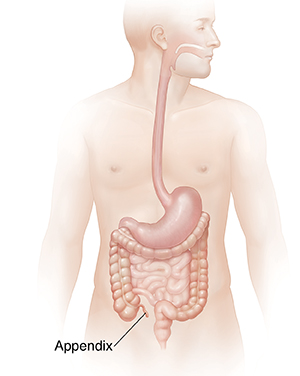Appendectomy
An appendectomy is surgery to remove the appendix. The goal is to remove the appendix safely. In most cases, the surgery takes about 30 to 60 minutes. If your appendix has burst, surgery may take longer.

Before surgery
-
Before surgery, you'll be asked to sign an informed consent. Signing this form means you understand the risks and benefits of the procedure. Be sure all of your questions are answered before you sign.
-
Tell your healthcare provider about all the medicines you take. This includes prescription and over-the-counter medicines. It also includes vitamins, herbs, and other supplements.
-
You may get fluids, antibiotics, and other medicines through an IV (intravenous) line. Tell your provider if you're allergic to any medicines or have any other health concerns.
-
You'll be given anesthesia just before your appendectomy. This keeps you pain-free and allows you to sleep during the surgery.
Types of surgery
An appendectomy may be done in 2 ways. Your surgeon will discuss which method is best for you:
-
Open surgery. One cut (incision), several inches long, is made in your lower right side. A bigger incision may be used if the appendix has burst.
-
Laparoscopic surgery. About 2 to 4 small incisions are used. One is near your belly button. The others are on other parts of your belly (abdomen). A thin tube with a tiny camera attached (laparoscope) is inserted through 1 incision. The camera shows the inside of your abdomen on a video screen. This image helps guide the surgery. Tiny surgical tools are put into the other incisions.
Finishing the surgery
In most cases, the full incision is closed with stitches or staples. Your surgeon may place a short-term (temporary) drain in the wound or in your abdomen. This helps remove any extra fluid. This may help prevent infection. This drain is usually taken out before you're discharged. If your appendix has burst, the outer layers of the incision may be left open. Leaving the skin open prevents infection from forming under the skin. It may heal on its own. Or it may be closed about 5 days later.
After the surgery
Keep any advised follow-up appointments with your healthcare provider. If you're told to take any medicines, take them as directed. If you're given breathing exercises, do them as directed. After the surgery, your removed appendix is checked under a microscope. Your provider will tell you the results.
When to call your healthcare provider
Call your healthcare provider if you have any of these:
-
Swelling, oozing, pain that gets worse, or redness near the incision
-
A fever of 100.4° F (38° C) or higher, or as advised by your provider
-
Belly pain that gets worse
-
Severe diarrhea, bloating, or constipation
-
Upset stomach (nausea) or vomiting
-
Leg pain or swelling
Call 911
Call 911 right away if you have trouble breathing.
Online Medical Reviewer:
Heather M Trevino BSN RNC
Online Medical Reviewer:
Robyn Zercher FNP
Online Medical Reviewer:
Ronald Karlin MD
Date Last Reviewed:
4/1/2024
© 2000-2024 The StayWell Company, LLC. All rights reserved. This information is not intended as a substitute for professional medical care. Always follow your healthcare professional's instructions.